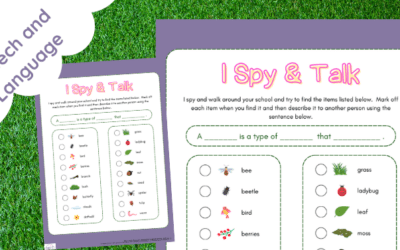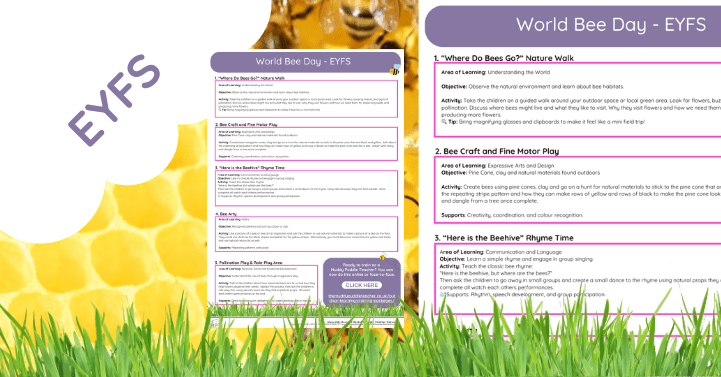Bee Day Lesson Plan Ideas for the Baby Room A buzzing bundle of baby-safe sensory fun for World Bee Day! Celebrate...
Nature Flash Cards (Outdoor Learning)
Apr 10, 2025
Nature Flash Cards – Outdoor Learning EditionSpark curiosity and build vocabulary with every step outside! Make every...
Outdoor Learning I Spy & Talk
Apr 10, 2025
Outdoor Learning “I Spy and Talk”Build language, observation, and connection through nature play. Turn every outdoor...
Outdoor Learning Colour Wheel
Apr 4, 2025
Outdoor Learning Colour Wheel🎨 Bringing colour and curiosity to outdoor learning! Make nature your classroom with our...
Outdoor Learning Colour Scavenger Hunt
Apr 4, 2025
Bug Outdoor Learning Scavenger Sheet
Apr 4, 2025
Outdoor Learning Scavenger Hunt Tick SheetInspire curiosity. Explore the outdoors. Learn through play. Make outdoor...
Outdoor Learning Activities for Nursery – Resource Pack
Mar 29, 2025
Outdoor Learning Activities for Nursery – Resource Pack 🌿✨ Bring early years learning to life with our Outdoor...
Nature Craft Christmas – Fine Motor Task
Dec 17, 2024
Nature Craft Christmas Templates – Outdoor Festive Fun! Product Description: Bring the magic of Christmas and the...
24 Nature Crafts for Advent
Nov 14, 2024
24 Nature Crafts for Advent: A Journey of Creativity and Connection Celebrate the season with "24 Nature Crafts for...
Craft Ideas for Babies in Autumn
Nov 13, 2024
Craft Ideas for Babies in Autumn – Ideas Pack Introducing the "Craft Ideas for Babies in Autumn" Ideas Pack—a...
Mud Kitchen Recipe (Autumn Theme)
Nov 12, 2024
Product Description: Mud Kitchen Recipe Kit – Autumn Theme Ignite your child's imagination and connection with nature...
Mud Kitchen Recipes (Bonfire Night)
Nov 12, 2024
Ignite creativity and sensory exploration with our Mud Kitchen Recipes: Bonfire Night Theme! This unique collection of...
Autumn Nature Emotions
Nov 11, 2024
Autumn Nature Emotions: Explore Feelings with Loose Parts Introduce children to emotions hands-on, nature-inspiredly...
Autumn Nature Numbers 0-20 (Outdoor Displays)
Nov 11, 2024
Autumn Nature Numbers: Engaging Display for Indoor & Outdoor Learning Spaces Celebrate the beauty of autumn while...
Autumn Nature Letters (Capitals)
Nov 10, 2024
Autumn Nature Letters: Bring the beauty of autumn into early years settings with our Capital Autumn Lettering—a...
10 Outdoor Sensory Activities for Babies
Nov 9, 2024
10 Outdoor Sensory Ideas for Babies: Nature-Based Fun for Little Ones Outdoor sensory play is a wonderful way for...
Outdoor Continuous Provision Plan for Early Years: Rainy Day Activities
Nov 8, 2024
Product Description: Outdoor Continuous Provision Plan for Early Years – Rainy Day Activities Turn rainy days into...
Outdoor Continuous Provision Plan for Early Years: Water Theme
Nov 8, 2024
Product Description: Outdoor Continuous Provision Plan for Early Years: Water Theme (MPT Approach) Bring the wonder of...





























